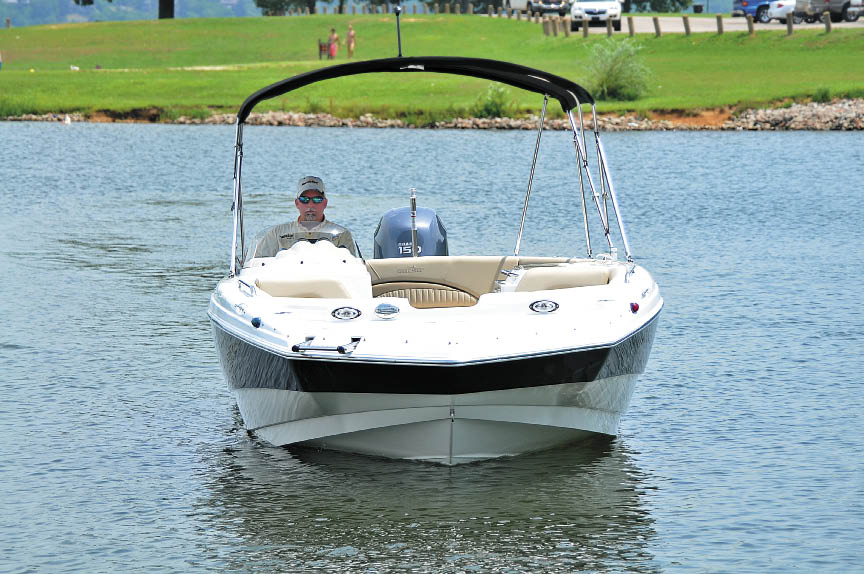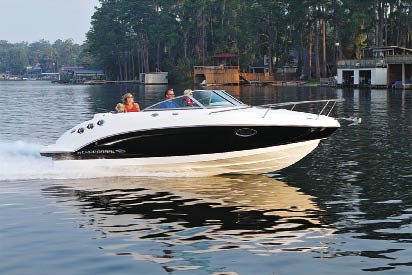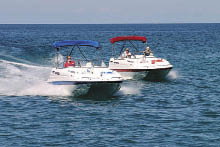 Nautical history has great tales of people powering boats with only wind or handmade oars; some evidence dates these stories back to B.C. times. Even all the way back then, early boat designers discovered boats were easier to steer and, more importantly, faster if the bow was rounded. Keeping the bow rounded also allowed them to lower the center of gravity, which helped keep the boat upright even in bad weather. These early boats were constructed with displacement hulls. This design enables the hull to cruise through the water by displacing it. Displacement hulls still make sense today for some uses as they typically produce more cargo room and better fuel efficiency. But with the invention of mechanical power came planing hull boats, which lift the boat partially out of the water to skim on the surface at a much quicker pace. Hopefully, we can all agree that we are glad to live in a time where we can take advantage of technology. While we aren't afraid of a little hard work, boating is arguably more fun than it used to be.
Nautical history has great tales of people powering boats with only wind or handmade oars; some evidence dates these stories back to B.C. times. Even all the way back then, early boat designers discovered boats were easier to steer and, more importantly, faster if the bow was rounded. Keeping the bow rounded also allowed them to lower the center of gravity, which helped keep the boat upright even in bad weather. These early boats were constructed with displacement hulls. This design enables the hull to cruise through the water by displacing it. Displacement hulls still make sense today for some uses as they typically produce more cargo room and better fuel efficiency. But with the invention of mechanical power came planing hull boats, which lift the boat partially out of the water to skim on the surface at a much quicker pace. Hopefully, we can all agree that we are glad to live in a time where we can take advantage of technology. While we aren't afraid of a little hard work, boating is arguably more fun than it used to be.
Deep Vee Hull
Planing hull boats can move very swiftly through smooth water, but usually need to slow down through choppy water in order to avoid boat damage and in some cases, personal injury. These hulls can be separated into two categories. The first type would be those having little or no deadrise, which yields high efficiency on calm water. The second would be those having substantial deadrise, which is known as a Deep Vee hull and creates a smoother ride in rough water. Developed back in the late 50s by C. Raymond Hunt, Deep Vee hulls are designed to operate at high speeds but they are not as efficient as flat or round bottomed boats, which mean they need larger engines to move at similar speeds. They offer a good ride in rough water as the pointed bow slices forward and the V-shaped bottom reduces the up-and-down movement of the boat. It won't plane at the same speed as a flat bottom boat, but pushes through the water at almost the same efficiency as a round bottom hull. The angle of the V tends to flatten out as it moves closer to the stern and it is the biggest factor in determining planing capabilities of the boat. This hull form is considered one of the most proven designs based on the smooth ride, plus the high rise out of the water.
Modified Vee Hull
If you don't think that a Deep Vee is the right choice for you, you have some other options. One thing to consider may be a Modified Vee hull, especially if the lake or river you plan to frequent has a lot of chop to it. The Modified Vee combines a Deep Vee at the bow but it becomes much shallower at the transom. This prevents the boat from drifting lazily across the lake, but still allows for a smooth ride while traveling at higher speeds. The shallower V deadrise enables the boat to plane quickly but steadies the craft while resting. A boat with this hull form can reach respectable speeds, which makes it a good choice for a family boat. One manufacturer who offers the modified Vee hull is Nautic Star. Its exclusive hull design has a shallow draft dead rise at the transom for stability while the boat is at rest. Forward there is a full Vee to give a softer ride in rougher waters. The hull also incorporates an air-assisted chine that releases water, helping the boat to plane quicker and lift higher. Both the engineers and craftsmen at NauticStar are rich in boat-building knowledge. They pride themselves on separating boats that what will simply work to making those that will work exceptionally well.
Deep Vee with Reverse Chine
 This hull is exactly how it sounds. It's a Deep Vee with a two-corner chine, which means before the bottom of the boat meets the side; it forms an upside-down V-shape which deflects spray away from the boat and offers greater stability at rest. When cruising around, the reverse chine helps with responsive turning at a higher speed. While most boaters appreciate the drier rider, there has been some complaint about the additional noise of the chine continuously hitting the water while the boat is at rest. Knowing that reverse chine hull designs are built for performance-enhancing lift, efficiency and agility might make a small noise setback worth it.
This hull is exactly how it sounds. It's a Deep Vee with a two-corner chine, which means before the bottom of the boat meets the side; it forms an upside-down V-shape which deflects spray away from the boat and offers greater stability at rest. When cruising around, the reverse chine helps with responsive turning at a higher speed. While most boaters appreciate the drier rider, there has been some complaint about the additional noise of the chine continuously hitting the water while the boat is at rest. Knowing that reverse chine hull designs are built for performance-enhancing lift, efficiency and agility might make a small noise setback worth it.
Extended V-Plane Hull
In 1965 when Chaparral boats began, it was a small fiberglass boating operation. Now they have over a million satisfied customers and countless boating awards. All of these things are due in no small part to the hands-on leadership of their company and their mission to always keep achieving better results in everything they do, including hull design.
"We have been using our Extended V-Plane design for many years," said Chaparral representative Christopher Gates. "However, we are constantly improving the shape of the bottom to increase efficiency, speed and comfort."
Extended V-Plane moves the propulsion point, where the stern drive meets the transom, forward of the aft running surface. This added length acts like a trim tab, allowing the boat to stay on plane at slower speeds with improved fuel economy. The longer running surface also bridges the waves better, which produces a softer ride in rough conditions and tracks better in tight turns.
"You won't find a quicker planing V-bottom boat," said Gates. "No matter how many passengers are on our boats, you'll enjoy added stability while wakeboarding, diving, fishing or swimming."
Quicker planning time is important for water sport activities. Extended V-Plane design allows the boat to plane quicker and stay on plane at slower speeds for an efficient ride when wakeboarding. Safety is also extremely important to Chaparral. Its hull bottoms are consistent in tight turns, making them dependable in the event you need to dodge an obstruction.
Modified Dihedral Vee Hull
 Starcraft Marine began back in 1903 and is still run today by the same family. Founder Harold Schrock helped pioneer the boating industry with innovative designs in both aluminum fishing boats and fiberglass deck boats. One of their greatest engineering feats is their Modified Dihedral Vee Hull. This revolutionary deck boat hull design virtually eliminates rough ride and rocking motion, while air injection vents provide a smooth, dry and stable trip that any rider could appreciate. Dihedral in the planing hull world is a term used to describe a deeper Vee down the centerline with two outer sponsons with reversed chines. These work together to eliminate side-to-side rocking and tendency to tip. This hull was specifically designed for a smooth ride in rough water. While you throttle up, you will quickly climb onto plane and have essentially no bow rise restricting visibility at the helm. These vented chines assist with lift. Now you know why there's a sense of pride at Starcraft and the boats that are manufactured by this family-run company.
Starcraft Marine began back in 1903 and is still run today by the same family. Founder Harold Schrock helped pioneer the boating industry with innovative designs in both aluminum fishing boats and fiberglass deck boats. One of their greatest engineering feats is their Modified Dihedral Vee Hull. This revolutionary deck boat hull design virtually eliminates rough ride and rocking motion, while air injection vents provide a smooth, dry and stable trip that any rider could appreciate. Dihedral in the planing hull world is a term used to describe a deeper Vee down the centerline with two outer sponsons with reversed chines. These work together to eliminate side-to-side rocking and tendency to tip. This hull was specifically designed for a smooth ride in rough water. While you throttle up, you will quickly climb onto plane and have essentially no bow rise restricting visibility at the helm. These vented chines assist with lift. Now you know why there's a sense of pride at Starcraft and the boats that are manufactured by this family-run company.
Catamaran Hull
 Power Catamaran Hull boats typically ride smoother than a Vee bottom boat. A Catamaran Hull impacts air which helps eliminates the pounding that can sometimes be associated with conventional hulls. Because there are two hulls with equal length symmetry, the boats are known for greater speeds without any additional engine horsepower. Compared to boats with a single hull, Catamarans offer increased distance between the center of gravity and the center of buoyancy, which provides higher stability. If one hull becomes damaged while out of the water, the boat will be able to stay afloat while a repair is being done. For this reason, most modern multihull designs are rated as unsinkable by various regulatory agencies. The downside of this hull is that it can be difficult to maneuver in tight marinas.
Power Catamaran Hull boats typically ride smoother than a Vee bottom boat. A Catamaran Hull impacts air which helps eliminates the pounding that can sometimes be associated with conventional hulls. Because there are two hulls with equal length symmetry, the boats are known for greater speeds without any additional engine horsepower. Compared to boats with a single hull, Catamarans offer increased distance between the center of gravity and the center of buoyancy, which provides higher stability. If one hull becomes damaged while out of the water, the boat will be able to stay afloat while a repair is being done. For this reason, most modern multihull designs are rated as unsinkable by various regulatory agencies. The downside of this hull is that it can be difficult to maneuver in tight marinas.
Hulls are constantly being looked at by all boat manufacturers. Striving for increased fuel efficiency without sacrificing any speed, you can bet that this area of the boat will be continually evolving. Take into consideration that type of hull you need on your boat will greatly depend on what you desire to do. But as long as we aren't paddling around in hollowed out logs, it will still be a good day on the water, no matter the hull type.

